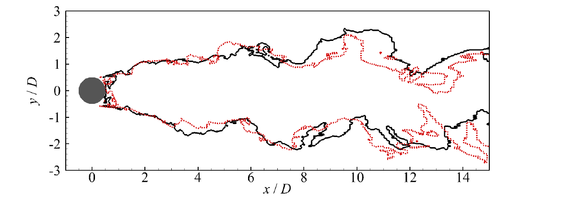The rapid advance of research on fluid mechanics in recent years is driven by a huge mass of data obtained from numerical simulations at various spatiotemporal scales, laboratory experiments, and field measurements. As a new technique, machine learning provides powerful tools to extract information from data that can generate knowledge about the underlying fluid mechanics. Additionally, machine learning offers a new data-processing framework that can transform the industrial application of fluid mechanics.
We use machine learning to improve the knowledge about turbulence. Criterion of detecting the turbulent/non-turbulent interface is a challenging topic in turbulence research. We train new detectors for identifying turbulent regions in the flow past a circular cylinder using machine learning. To ensure that the turbulent/nonturbulent interface is independent of the reference frame of coordinate and is physics-informed, invariants of tensors appearing in the transport equations of velocity fluctuations, strain-rate tensor, and vortical tensor are proposed as the input features to identify the flow state. Compared with the traditional detection method, the detector trained by machine learning captures simultaneously and objectively the different key properties of turbulent flows, including the unsteadiness, vortex stretching, and three dimensionalities, which also provides an accurate and novel definition of turbulence.
We also utilize the machine learning to develop an in-situ detection method for ocean currents, which is crucial to many applications in marine hydrodynamics and ocean engineering. Complex current velocity distributions can modulate wave dynamics in both the temporal and spatial aspects. We develop a data-driven deep-learning framework to detect the current based on surface-wave data. The framework takes wave data obtained from our high-fidelity simulation as the input and outputs the information of the current underneath, including its magnitude and spatial distribution. Without any a priori knowledge, the machine-learning algorithm can recover the interactions between broadband waves and vertically-sheared current. This method is promising for applications in naval hydrodynamics research.
Selected Publications:
- Xuan, A. & Shen, L (2023), “Reconstruction of three-dimensional turbulent flow structures using surface measurements for free-surface flows based on a convolutional neural network,” Journal of Fluid Mechanics, Vol. 959, A34.
- Zhang, Z., Hao, X., Santoni, C., Shen, L., Sotiropoulos, F. & Khosronejad, A. (2023), “Toward prediction of turbulent atmospheric flows over propagating oceanic waves via machine-learning augmented large-eddy simulation,” Ocean Engineering, Vol. 280, 114759.
- Hao, X. & Shen, L. (2022), “A novel machine learning method for accelerated modeling of the downwelling irradiance field in the upper ocean,” Geophysical Research Letters, Vol. 49, e2022GL097769.
- Gao, L., Gao, Q., Zhang, H., Li, X., Chaubell, M., Ebtehaj, A., Shen, L. & Wigneron, J. (2022), “A deep neural network based SMAP soil moisture product,” Remote Sensing of Environment, Vol. 277, 113059.
- Li, B., Yang, Z., Zhang, X., He, G., Deng, B. & Shen, L. (2020), “Use machine learning to detect turbulent region in flow past circular cylinder,” Journal of Fluid Mechanics, Vol. 905, A10.
- Li, T., Xuan, A. & Shen, L., "Study of nonlinear interaction between waves and ocean currents using high-fidelity simulation and machine learning", 33rd Symposium on Naval Hydrodynamics, 2020.

